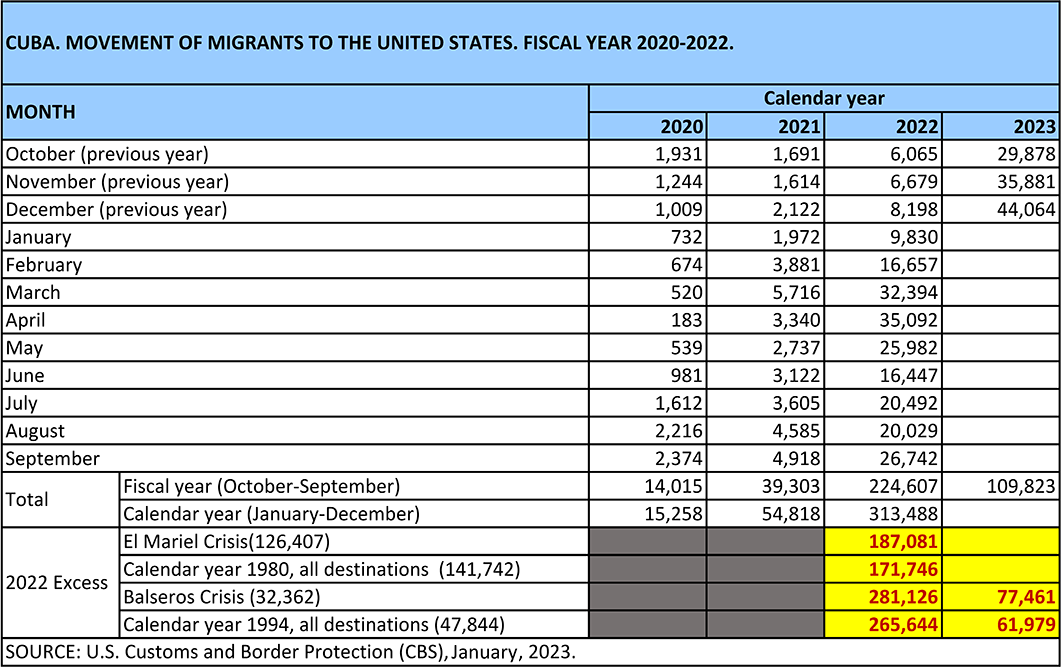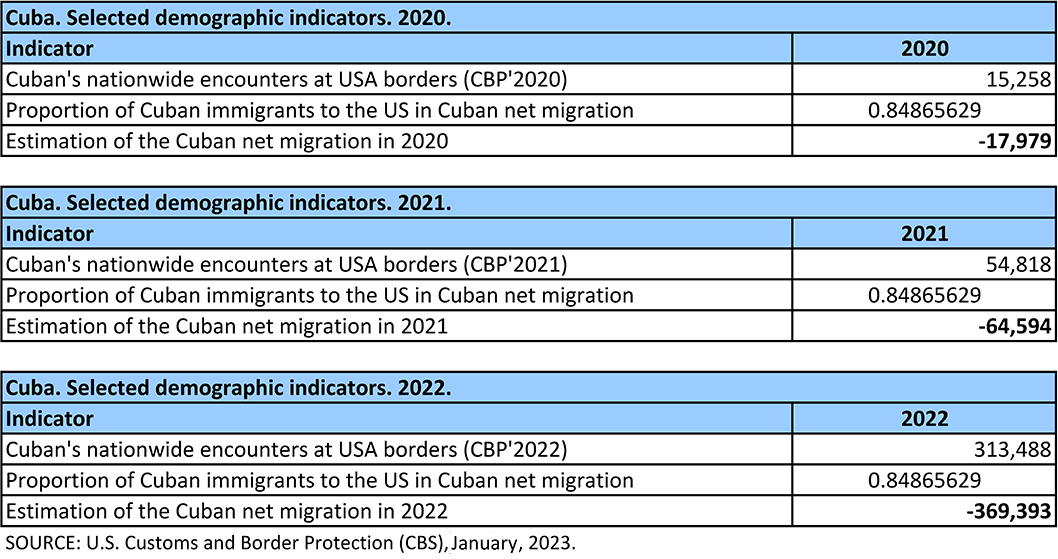Cuba and its Emigration: Exit as Voice
Juan Carlos Albizu-Campos Espiñeira
The Cuban migratory stampede of the last fifteen months has already caused a loss of 3.5% of the total population.
Cuban migrants crossing the border through Roma, Texas in April 2022.
Last September, after 26,742 Cubans entered North American territory, the monthly emigration of Cubans to the United States in 2022 reached its third largest total, following the March (32,394) and April (35,092) entries. In October, more than 29,000 (29,878) other Cubans arrived, surpassing the number registered in the previous month, and just under 11% of all migrant entries for that month to the United States from all other countries. In total, the number of Cuban migrants who entered the country in fiscal year 2022 was 224,607, slightly more than 8% of the total immigration registered in that period.
Nonetheless, in November 2022 a new record for Cuban entries was reached (35,881), surpassing all previous monthly entries since 2020. Currently, Cuba ranks fifth in the world among countries sending migrants to the United States. This number, however, does not include the 6,182 arriving by boat (the so-called “balseros”) between October 1, 2021 and September 30, 2022, or the further 2,982 balseros that came ashore between October1, 2022 and December 12, 2022. With the addition of these 9,164 balseros, the total number of Cuban arrivals rises even further to 269,652. To these should be added the 17,487 Cubans who, according to Mexican authorities, by December 15, 2022 had requested refuge in that country. Other Cubans were known to be in transit on their way to the U.S. southern border through South and Central America.
Finally, the culmination of the exodus occurred in December 2022, Cuban entries into the United States attaining their highest monthly level since 1981, reaching 44,064 people. That many migrants nearly equaled the total Cuban entries registered in 2012 (46,662), and significantly exceeds the number of arrivals during the 1994 Rafter Crisis (32,362).
In total, during the 2022 calendar year, 313,488 Cubans reached the United States, or slightly less than 3% of Cuba’s 2021 population (11,147,405). This number is nearly double the combined total of Cuban arrivals in the United States during the 1980 Mariel (126,407) and 1994 rafter crises (32,362).

In summary, the number of Cuban emigrants reaching any destination, as estimated by applying a coefficient (0.84865) that adjust the total by considering the weight of those entering the United States as a proportion of all net emigrants from Cuba, between January and December 2022 would amount to 369,393. That many migrants exceed:
- the number of migrants in the four years between 1959 and 1962 (354,963);
- the 333,457 who left Cuba bound towards the United States between 1966-1971, during the airlift known as the "Freedom Flights;"
- 3% of the 2021 Cuban population; and
- nearly double the aggregate net departures from Cuba, regardless of destination, in the exoduses in 1980 and 1994.
Looking at the 15 months between October 1, 2021 and December 31, 2022, the months encompassing this new migratory crisis, and considering the total number of Cuban migrants to all destinations as well as the diverse migratory corridors used, we have 394,070 migrants, 334,430 of which have already managed to enter the United States. Arrivals from October 1 to December 31, 2022 (109,823) were three times as numerous as during the 1994 Rafter Crisis (32,362).
It is difficult to predict the impact of President Biden's recently announced policy to limit the entry of irregular immigrants through the southern border with Mexico announced on January 5, 2023. Although it will contribute to the reduction of the migratory avalanche, it will only serve as a palliative for reducing Cuban emigration. And this for several reasons. Under this initiative, up to 30,000 migrants, from Venezuela, Cuba, Haiti and Nicaragua may request - as long as a sponsor assumes responsibility for their wellbeing in the United States - a temporary stay permit of up to two years. This policy is intended to be in force for the next two years, enjoys the endorsement of Mexico, and permanently bars prospective migrants from eventual entry for those attempting to cross the border without prior authorization. The policy stated that it will initially be used for those seeking an exception to Title 42 of the public health order, which the Biden administration has announced will expire in May, 2023.

Assuming that one quarter of those entry permits were granted to Cubans over the next two years, this would lead to the arrival of 180,000 more Cubans. In addition, the reactivation of the 1994 immigration agreement between the United States and Cuba guarantees that no less than 20,000 immigrant visas are to be issued to Cubans annually. Therefore, we can conclude that during the next two years, approximately 220,000 Cubans will be able to resettle in the United States. That is, of course, provided the United States does not count the family sponsorship program arrivals as part of the visas agreed under the 1994 immigration agreement. If the assumed combined number of visas are granted, the number of additional migrants arriving in the next two years would equal 70% of those who gained entry in 2022. If the U.S. does not double count, then the annual number of Cuban entrants will be nearly twice (66,516) the number of those who made it to the United States in 2016, the last year when the 1994 immigration agreement was in full force.
In the final analysis, the migratory bleeding does not seem to have an end in sight and will continue for as long as the 1994 immigration agreement remains in force. Moreover, many of the most recent immigrants will ultimately naturalize as United States citizens, eventually making use of the migratory preference system that grants priority to admission of relatives, particularly of close family members.
Nonetheless, it is officially said that the country is not confronting a migratory crisis. However, the first parameter the International Organization for Migration (IOM) considers when judging if there is a migratory crisis is the magnitude of the emigrant outflow. The numbers do not lie to the willing listener...
Labor Implications of the Emigration
In proportional terms, it is almost certain that 80% of the 2022 migrants are people between 15 and 59, the prime working ages. This represents a significant drain of population in the main economically active age groups. But even then, now and in the near future (but not before 2030) significant labor shortages will not occur. Other than the economically active, there are almost 3 million people in Cuba fit and qualified to work. However, the current economic model is not able to employ them. According to the 2012 Census, there were about 1.5 million people who declared themselves unemployed and not even looking for work. To those could be added the more than one million people whose jobs the government eliminated as they were determined to be redundant or not necessary. So, of the 7.6 million persons in 2012 between the ages of 15 and 64 able to work, only a little over 4 million were likely to have been employed.
So, of the 7.6 million people between the ages of 15 and 64 years, who are able to work and are considered labor resources, only a little over 4 million were likely to have been employed.
And this has nothing to do with the population’s demographic aging. In terms of the dependency ratio, currently there are more than two employed workers for each person under the age of 15 or over 65 years of age. Although Cuba did not take advantage of the now expired so-called demographic dividend - the age structure advantage whereby there was a relative abundance of individuals in the prime working ages – enjoyed by the country for several decades, the availability of labor remains abundant. Unfortunately, the Cuban economic model is incapable of maximizing the benefits that could accrue from the use of this available labor force.
Labor resources are not scarce in Cuba – they are wasted, squandered. This is one reason, among others, driving the dissatisfaction prevailing in the country, impelling people to emigrate, to exit. The inevitable consequence is that, if current emigration levels are maintained, the remaining demographic dividend will also be wasted.
Emigration and Demographic Aging
In the long term, the economic cost of the departure of so many will be even greater. Cuba is a worn-out and poor country with a ruined and obsolete infrastructure, very low productivity, indebted internationally and without financial reserves - public or private. In this scenario, the country will be forced to confront the reality of an aging population, where the growing number of senior citizens will reach retirement without any savings, while requiring more and more costly social and health services unavailable to them.
The labor resources in Cuba are not scarce. They are wasted, squandered.
It is also plausible to assume that despite filial and personal ties, the family preference system, part and parcel of U.S. immigration policy, will not necessarily be used to the benefit of senior citizens remaining behind. The policy requires U.S.-based sponsoring family members to assume financial responsibility for claimed relatives, so they do not become public charges. The question then becomes: How would a bankrupt state, currently unable to satisfy even the more basic needs, including the essential “guaranteed” food ration, be able to provide adequate pensions in the absence of required financial reserves and a stock market capable of sustaining them?
As much or even more critical is that the current economic model has prevented citizens themselves, as in most other countries, whether rich or developing, from saving or investing part of the salaries earned during economically active years to at least partially finance their retirement once they are no longer working.
The continued emigration will continue to aggravate, rather than alleviate, the consequences of demographic aging.
To this must be added the popular expectations, frustrated today, of access to minimum service levels. Those policies for decades were forged under the failed economic model as it was substantially subsidized, first by the Soviet Union and the socialist camp, and more recently by Venezuela, together with the resources obtained through international loans. Rarely has the nation repaid these loans. This is a discouraging scenario in a country whose government claims to want to attract foreign investment, ignoring that to do so it would necessarily have to compete with other destinations with more promising potential markets, but also offering environments encouraging private investment and legal guarantees.
The tax burden foreign investors will have to assume, directly or indirectly, if this growing mass of unprotected elderly is to be provided with an existence that, if not comfortable, is at least dignified, will represent an added cost they are likely to refuse to bear if they negatively affect their bottom lines. The current demographic trends are not auspicious in terms of Cuba's international competitiveness in attracting private capital. What is left? Emigrant remittances? But even their growing weight in the Cuban economy may not be sustainable in the long term, as the increasingly less numerous Cuban families, as fertility remains low and continues to decline, manage to reunite abroad thanks to continued emigration. If pensions are to be provided, someone will have to pay for them, whether directly or indirectly. And if in order to defray pension costs, the tax burden is unduly high, foreign investors may choose to put their money elsewhere. Foreign investors surely will not be willing to assume the burden. The reality is that they will not simply because they are not charitable institutions and will be looking for acceptable returns on their investments.
There is no other country that has regressed so much in terms of human development.
In any case, between 2007 and 2017 Cuba's Human Development Index fell from 51st to 73rd place in the international ranking. But then, from 2017 to 2021, it fell to 83rd place, dropping another 10 places, dragged down, among other things, by the loss of 6.2 years of life expectancy at birth. A drop of 32 places in just 15 years is alarming. But in Macondo nothing has happened, nor is it happening.
The Future and the Demographic Dynamics
It is also not acknowledged that the recent migratory stampede has already produced a population loss of 3.5% of Cuba’s inhabitants - regardless of how the Havana statistical authorities decide to classify those who left - such migration surges have only been observed in the context of armed conflicts.

But the authorities continue saying there is no migratory crisis. Instead, it is alleged the country faces a demographic challenge due to its low fertility levels. From this perspective, solutions are proposed that ignore real immediate problems, such as unbridled emigration. In addition to unrealistically promoting a fertility increase, were a rise in the number of births to materialize, it would aggravate other medium- and long-term problems such as the already high and rising dependency rates associated with the aging population. Nor is it openly recognized that there is poverty - be it relative, absolute, multidimensional, or whatever one wants to call it depending on the methodology used.
Meanwhile, the economic model does not seem to tackle any of these problems. As a matter of fact, these challenges are not mentioned in the official documents outlining the government’s economic policy. Nor is there reference to the popular expectations associated with the unfilled promises made by the adoption of the model itself. But these same unfulfilled dreams are the ones paving the migratory corridors through which so many are leaving the Island, despite the anguish engendered by such departures.
Viewed another way, one would have to ask: Isn't this massive emigration also the expression, through the exit, of a dissatisfied voice crying for change? In any event, the exodus of dissension does not guarantee continuity.

Juan Carlos Albizu-Campos Espiñeira has a degree in Industrial Economics, University of Havana (1986). Specialist in Demography, Latin American Center for Demography, Costa Rica (1989). Doctor in Economic Sciences, University of Havana (2001) and Doctor in Demography, University of Paris X-Nanterre (2002). Full Professor of the Center for the Study of the Cuban Economy (CEEC), of the University of Havana.
He has published, among other works, Cuban Demographic Dynamics: Background for an Analysis; Fertility, GDP and Average Real Wage in Cuba; The International Migration of Cubans: Current Scenarios; Cuba: Demographic Scenarios towards 2030; Towards a Population Policy Oriented to Human Development; Cuba: A Look at the Economically Active Population; Cuba: Aging and Demographic Dividends; Development Challenges; Is the Decline in the Economic Activity of the Population a Temporary Phenomenon in Cuba?; "Demographic Dismay? "; "A Ghost Haunts Cuba"; Life Expectancy in Cuba Today: Differences and Conjunctures; Maternal Mortality in Cuba: Color Counts.
He has received several National Awards from the Cuban Academy of Sciences and the University of Havana.

Sergio Díaz-Briquets has published academic articles and several books on Cuba-related topics, emphasizing demographic and environmental issues. Among them are The Health Revolution in Cuba and as co-author of Conquering Nature.
Currently, he is an independent consultant. His previous institutional affiliations include Research Director of the Bipartisan U.S. Congressional Commission for the Study of International Migration and Cooperative Economic Development, Program Officer at Canada’s International Development Research Center (IDRC), as well as positions with universities, non-profit organizations and international consulting firms. He is a graduate of the University of Miami and Georgetown University and received a Ph.D. in Demography from the University of Pennsylvania.

